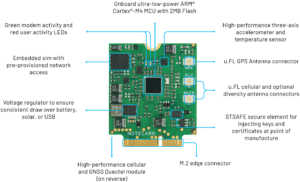Battery technology has advanced dramatically in the last ten years. Improved battery performance and reduced cost is enabling new and expanded use cases for remote monitoring and control. Solar power and whole-house standby power (generators and battery) come to mind.
I will be attending the RE+ Tech event in Anaheim, CA September 19-22. I’d love to talk to you about LTE connectivity and off-grid power for your project to see if we can help solve your wireless IoT connectivity and data routing needs. Feel free to connect with me on LinkedIn or reach out on my conference-specific line (760) 239-9151.
About RE+ Tech
RE+ Tech is the premier event for the technical and scientific cohorts of renewable energy professionals to network and innovate during RE+, the “largest and most comprehensive event in North America for the clean energy industry”.
The event draws almost 20,000 professionals from around the world, and is largely focused on accelerating decarbonization goals and pushing the technical advancements that will get us to net zero.

Cellular IoT and Renewable Energy Solutions
You might first be wondering, what is cellular IoT? In his post covering the topic, Rob Lauer defines cellular IoT as the technologies that enable “physical devices (e.g. sensors, actuators, and their host microcontrollers or single-board computers) to connect to a private network or the public Internet for the purpose of transmitting data.”
LTE connectivity is a wireless standard that provides the reliability, low latency, and low scaling costs required to support IoT-enabled renewable energy technologies like smart grids, microgrids, electric vehicles, photovoltaic systems, and smart buildings.
Since many devices to be monitored and controlled will not be connected to main power, there are a handful of important wireless connectivity considerations when designing a system:
- Power Consumption: The IoT connectivity solution should be low power by default to minimally impact battery life and reduce heat. Ideally it would provide intermittent, on-demand connectivity options so as not to be a constant power draw.
- Size: Where possible, the connectivity solution should be small enough to provide flexibility in the final package, and align with the use case mechanical and environmental requirements.
- User Experience (UX): Eliminate any dependency upon user knowledge and plan for how the product will function in its intended setting. It should just work for the end-user. This results in higher customer satisfaction, more reliable connection, lower customer support cost, and a more complete data set.
- Mobility: Strive to be as independent of infrastructure as possible. Devices should be “free to roam” around the country.
- Economics: The longest range, most efficient options are worthless if the unit economics don’t make sense.
Carefully consider the pros and cons of all possible technologies. Select the one (or more) most suitable for the mission and sustainable – technically and economically – over the life of the product.

Real World Examples
Here are two recent examples from my own life that highlight how design choices impact the end-user:
- I installed some rather pricey motorized blinds from a well-known brand a few years ago in several rooms of my home. The blinds connect wirelessly to a proprietary hub that must be connected to my router via an ethernet cable. It worked great for two years, UNTIL…
I changed my ISP, and this necessitated moving my router. Now the hub is too far from the blinds in the living room, and they don’t work. I can solve this several ways (including a proprietary $100 repeater), but I really shouldn’t have to do anything simply because I moved my router less than 100 feet. It comes down to the choices the device designers made when selecting a connection technology that has a range of 30-60 feet (that is their spec). There was seemingly little foresight into UX, and now they have (at least) one less consumer buying their blinds.
- While my house is not large, I do live on a large rural property with a gate at the top of my drive. My gate opener only has a range of about 100-200 feet, eliminating the possibility of me controlling the gate unless I’m right next to it. The only option the manufacturer provides is a $400 add-on (3G!) connection with a monthly subscription. But at least in this case, they expose and document the pins on the controller board for opening and closing the gate, as well as a few gate status pins.
Luckily, I work for Blues Wireless who makes a postage stamp-sized Notecard that provides wireless connectivity and data almost instantaneously. For $49-69 I can use the Notecard to connect to the control pins (I don’t even need a microcontroller for the basic functionality) and use LTE connectivity to control my gate from my phone around the globe. It includes 5,000 Consumption Credits for data routing and events (in this case status checks or open/close requests). That is probably enough for the next five years but if I need more credits, they are a fraction of a cent.
Out-of-the-Box LTE Connectivity
The Blues Wireless Notecard is a great solution for many off-grid power solutions. It has global LTE connectivity out of the box, includes data routing and events with no recurring data plan. Pricing discounts for additional data services scale with your project needs. It’s a super low-power component (8 microamps at rest) with intermittent connectivity and it can be powered by solar.

Accelerating Renewable Energy Solutions with IoT
As we collectively move to adopt more sustainable off-grid energy sources and integrate them with our existing technologies and infrastructure, efficiency and scalability will be paramount. The data visibility and remote access the IoT provides will accelerate the transition by bridging traditional infrastructure with new technologies. Selecting the right components, including connectivity hardware, will determine the deployment timeline and cost, and the scalability of your solution.

